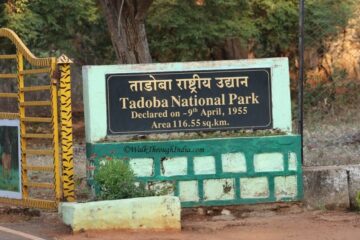
The most well-known national park in India, Bandhavgarh National Park, is located in the Vindhya Hills in Madhya Pradesh’s Umaria district. The 105 km2 Bandhavgarh National Park was created in 1968 and is the largest national park in the country. The most famous hilltop in the Umaria district is the source of the name Bandhavgarh. In addition to being known for having the highest density of tigers in all of India, Bandhavgarh is a region rich in biodiversity. In the same way, the park is home to the greatest reproductive population of deer and leopards. The park’s tiger species count has increased significantly over the years, and this is the cause.
Bandhavgarh National Park: A Haven for Tigers and Biodiversity
Location and Overview:
Nestled in the Vindhya Hills of Umaria district in Madhya Pradesh, India, Bandhavgarh National Park is one of the country’s most renowned wildlife sanctuaries. It is named after the Bandhavgarh Hill, which is crowned by the ancient Bandhavgarh Fort. Spread across approximately 450 square kilometers, the park is celebrated for its rich biodiversity, especially its thriving population of Bengal tigers.
Key Features:
1. Rich Fauna:
- Bengal Tigers: Bandhavgarh is famed for its high density of Bengal tigers. The park’s robust tiger population makes it a prime destination for tiger enthusiasts and wildlife photographers.
- Other Wildlife: Apart from tigers, the park is home to diverse fauna, including leopards, sloth bears, spotted deer (chital), sambar deer, wild boars, Indian bison (gaur), and various species of birds and reptiles.

2. Flora:
- Sal and Bamboo Forests: Bandhavgarh is primarily covered with dense sal forests, interspersed with bamboo groves. These forests provide an ideal habitat for a variety of wildlife.
3. Bandhavgarh Fort:
- Historical Significance: The ancient Bandhavgarh Fort, perched on a high cliff, offers panoramic views of the surrounding landscape. It is believed to date back to the Ramayana era, adding historical allure to the park.
4. Biodiversity:

- Avian Species: Bandhavgarh is a paradise for birdwatchers, with over 250 species of birds, including eagles, vultures, owls, and numerous migratory birds during winter.
- Floral Diversity: The park showcases a variety of flora, including dhok trees, grasslands, and aquatic plants around water bodies.
5. Conservation Efforts:
- Tiger Conservation: Bandhavgarh actively participates in tiger conservation efforts, focusing on anti-poaching measures, habitat preservation, and scientific research to ensure the survival of this iconic species.
- Community Engagement: The park collaborates with local communities, promoting sustainable practices and providing livelihood opportunities to reduce human-wildlife conflict.
6. Safari Experience:

- Jeep and Elephant Safaris: Visitors can explore the park through jeep safaris, allowing close encounters with wildlife. Additionally, elephant safaris offer a unique vantage point for spotting tigers and other animals.
7. Responsible Tourism:
- Eco-friendly Initiatives: The park promotes responsible tourism, emphasizing eco-friendly practices to minimize the impact on the environment.
- Education and Awareness: Bandhavgarh educates visitors about the importance of wildlife conservation, fostering awareness about the park’s flora, fauna, and conservation challenges.
8. Best Time to Visit:
- Wildlife Sightings: The park is open to visitors from October to June, with the best wildlife sightings during the dry months of April to June when animals gather around water sources.
Bandhavgarh National Park, with its captivating wildlife and scenic beauty, offers a mesmerizing glimpse into the natural world. Whether you’re a wildlife enthusiast, nature lover, or history buff, a visit to Bandhavgarh promises an unforgettable adventure in the heart of India’s wilderness.
JUNGLE SAFARI IN BANDHAVGARH TIGER RESERVE

Jungle Safari in Bandhavgarh Tiger Reserve: A Thrilling Wildlife Odyssey
Introduction:
Bandhavgarh Tiger Reserve, nestled in the Vindhya Hills of Madhya Pradesh, India, is a sanctuary of raw natural beauty and biodiversity. Embarking on a jungle safari here is a captivating experience, offering glimpses into the lives of the elusive Bengal tigers and a myriad of other wildlife species. Here’s a guide to help you make the most of your jungle safari in Bandhavgarh:
1. Types of Safaris:
- Jeep Safaris: Jeep safaris are the most popular way to explore the reserve. Accompanied by experienced guides, these open-top vehicles allow close encounters with wildlife while ensuring safety and comfort.
- Elephant Safaris: Elephant safaris offer a unique perspective. Sitting atop these gentle giants, you can quietly approach animals, especially tigers, without disturbing them.
2. Best Times for Safari:
- Morning Safaris: Early mornings offer the best chance to spot wildlife, as animals are active during the cooler hours. The soft morning light enhances photography opportunities and creates a serene atmosphere.
- Evening Safaris: Evening safaris present a different ambiance. As the day transitions to night, you might encounter nocturnal creatures, providing a unique safari experience.
3. Wildlife Encounters:
- Bengal Tigers: Bandhavgarh is renowned for its tiger sightings. Witnessing a majestic tiger in its natural habitat is a highlight of any safari, creating memories that last a lifetime.
- Leopards and Other Fauna: Apart from tigers, the reserve hosts leopards, spotted deer, sambar deer, bison, langurs, various bird species, and more. Each safari holds the potential for exciting wildlife encounters.
4. Guided Experience:
- Expert Naturalists: Every safari includes knowledgeable naturalists who share their insights about the flora, fauna, and behavior of the animals. They enhance your safari experience with their expertise.
5. Responsible Tourism:
- Respect Wildlife: It’s crucial to maintain a respectful distance from animals to avoid stressing them. Follow the guides’ instructions and maintain silence during sightings.
- Eco-friendly Practices: Embrace eco-friendly practices. Avoid littering, respect the park’s rules, and appreciate the wilderness without disrupting its natural balance.
6. Permits and Booking:
- Advance Booking: Safaris require permits, which are best obtained through advance online bookings. Ensure you secure your permits and accommodations well in advance, especially during peak seasons.
7. Photography Tips:

- Camera Gear: Bring a good zoom lens to capture wildlife from a distance. However, always be mindful of the animals’ comfort and do not use flash photography.
- Patience and Observation: Wildlife photography requires patience. Observe animal behavior, anticipate movements, and be ready to capture those magical moments.
A jungle safari in Bandhavgarh Tiger Reserve is not just an excursion; it’s an intimate rendezvous with nature’s grandeur. The sights, sounds, and sheer thrill of encountering wild animals in their natural habitat make this experience extraordinary. As you embark on this adventure, remember to be mindful of the environment, respect the wildlife, and savor the profound connection with the untamed wilderness.
Jungle Safari Timings:
- Morning Safaris: Usually, morning safaris start at sunrise and last until late morning. This is the best time to spot wildlife as animals are active, and the soft morning light is ideal for photography.
- Evening Safaris: Evening safaris commence in the late afternoon and continue until sunset. The cooler temperatures often attract wildlife to water sources, providing excellent opportunities for sightings.
1. Safari Zones:

Many wildlife reserves are divided into distinct zones to manage visitor numbers and minimize environmental impact. Here’s how safari zones work:
- Zone Rotation: Safari zones are rotated to distribute visitor pressure evenly across the reserve. Visitors are allocated specific zones for their safaris, ensuring a fair chance to explore different parts of the park.
- Booking and Permits: When booking a safari, you are assigned a specific zone. It’s essential to obtain the necessary permits for your chosen zone in advance. Permits are limited and subject to availability.
2. Advantages of Different Zones:
- Core Zones: Core zones generally have higher chances of tiger sightings and are more ecologically sensitive. These areas are often rich in biodiversity and offer a pristine wilderness experience.
- Buffer Zones: Buffer zones are peripheral areas of the reserve. While tiger sightings are possible here, these zones are often less crowded, providing a quieter and more relaxed safari experience.
3. Tips for Safari Enthusiasts:
- Plan Ahead: Research the reserve you plan to visit. Understand the zones, their attractions, and the best seasons for wildlife sightings.
- Arrive Early: Arriving early ensures you have ample time to complete entry formalities and secure your safari vehicle. Morning safaris are especially rewarding due to increased animal activity.
- Respect Wildlife: Maintain silence during sightings, avoid sudden movements, and follow the guide’s instructions. Respect the animals’ space and natural behaviors.
- Pack Wisely: Carry essentials like water, sunscreen, insect repellent, a hat, camera gear, and any necessary medications. Dress in earthy tones to blend into the surroundings.
- Follow Regulations: Adhere to park rules and regulations. Stay within designated pathways and roads. Responsible behavior ensures the safety of both visitors and wildlife.
Understanding jungle safari timings and zones allows you to optimize your wildlife experience. By respecting the natural environment and following guidelines, you contribute to the conservation efforts while enjoying the wonders of the wild. So, gear up, respect the wilderness, and embark on a memorable safari adventure!



